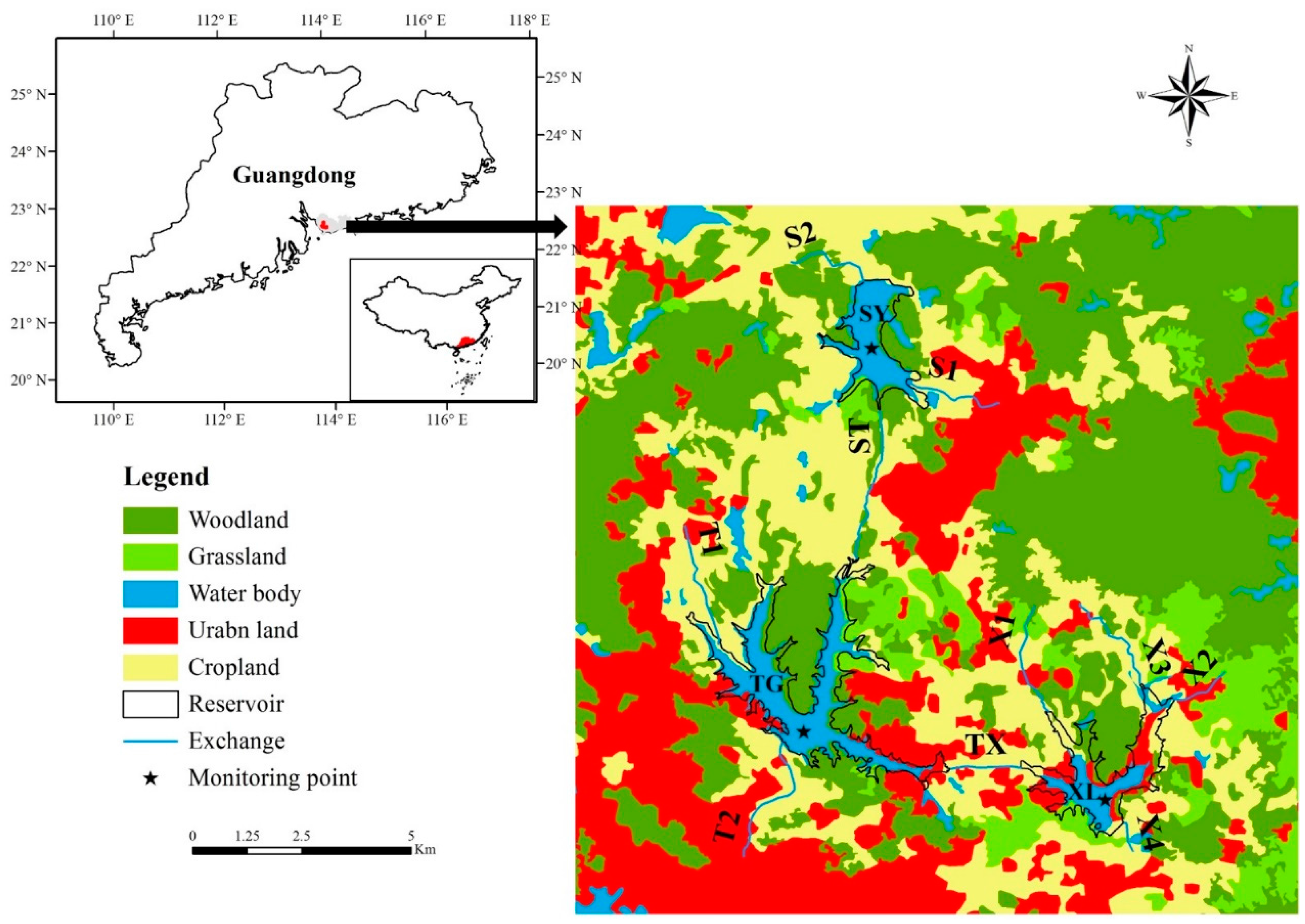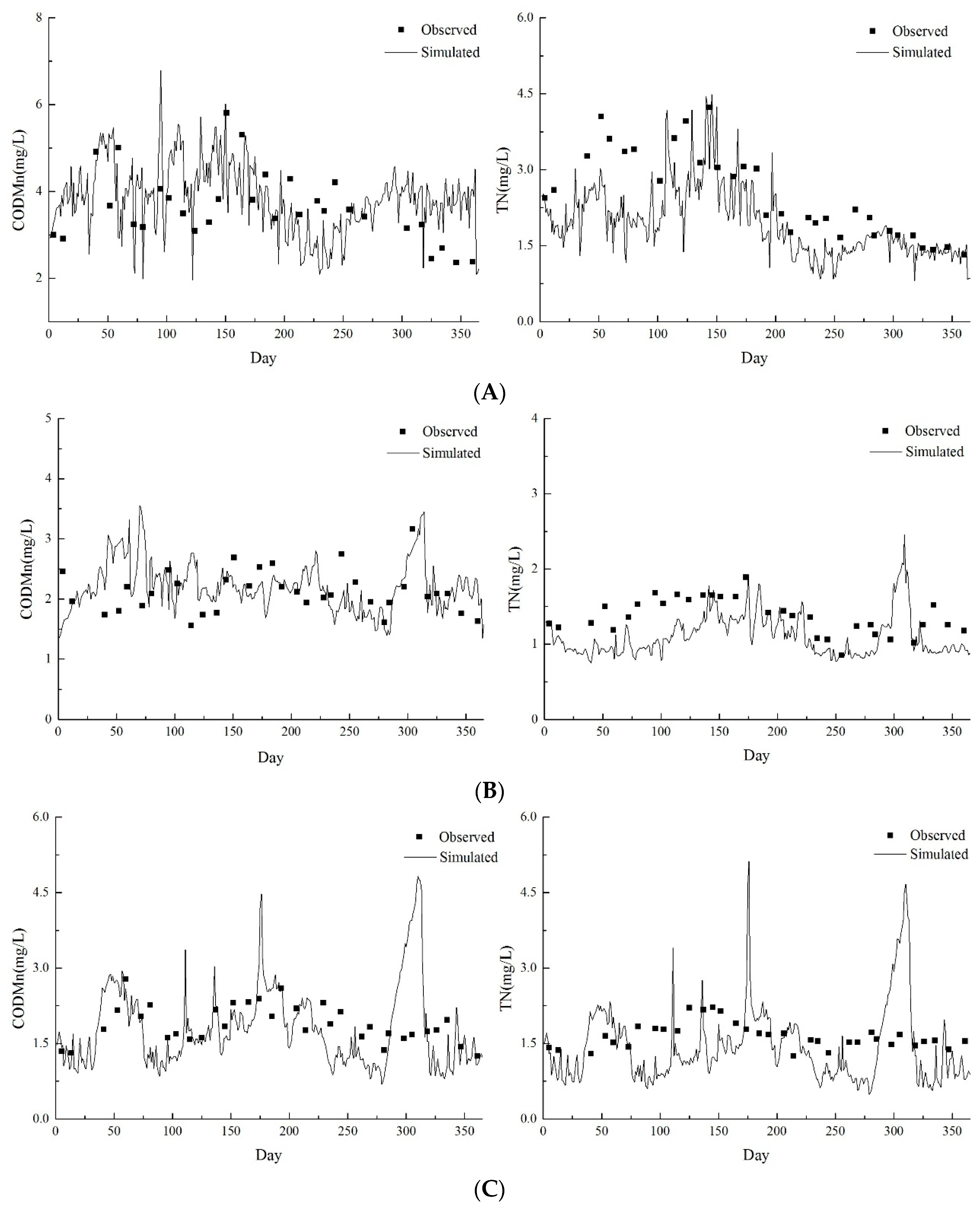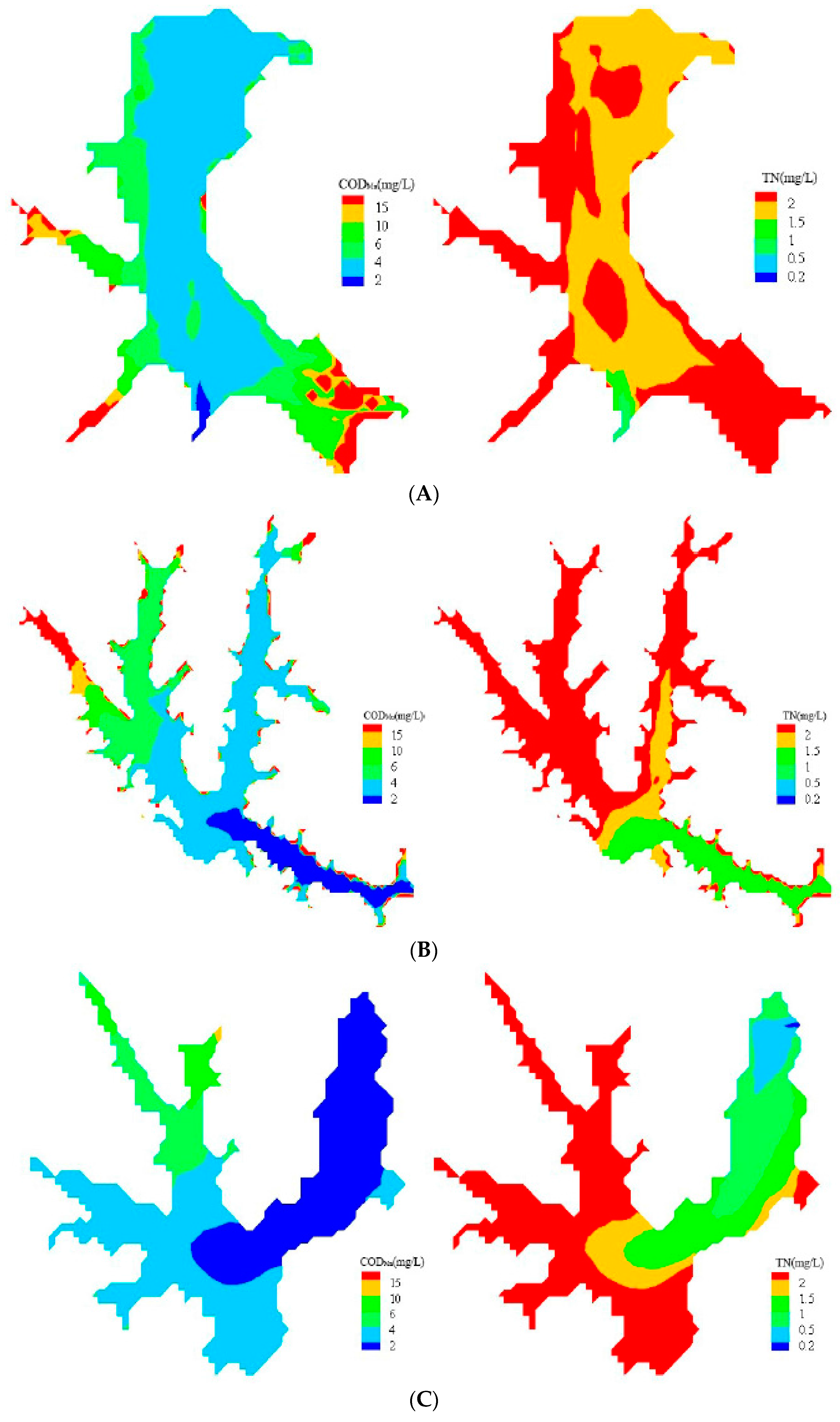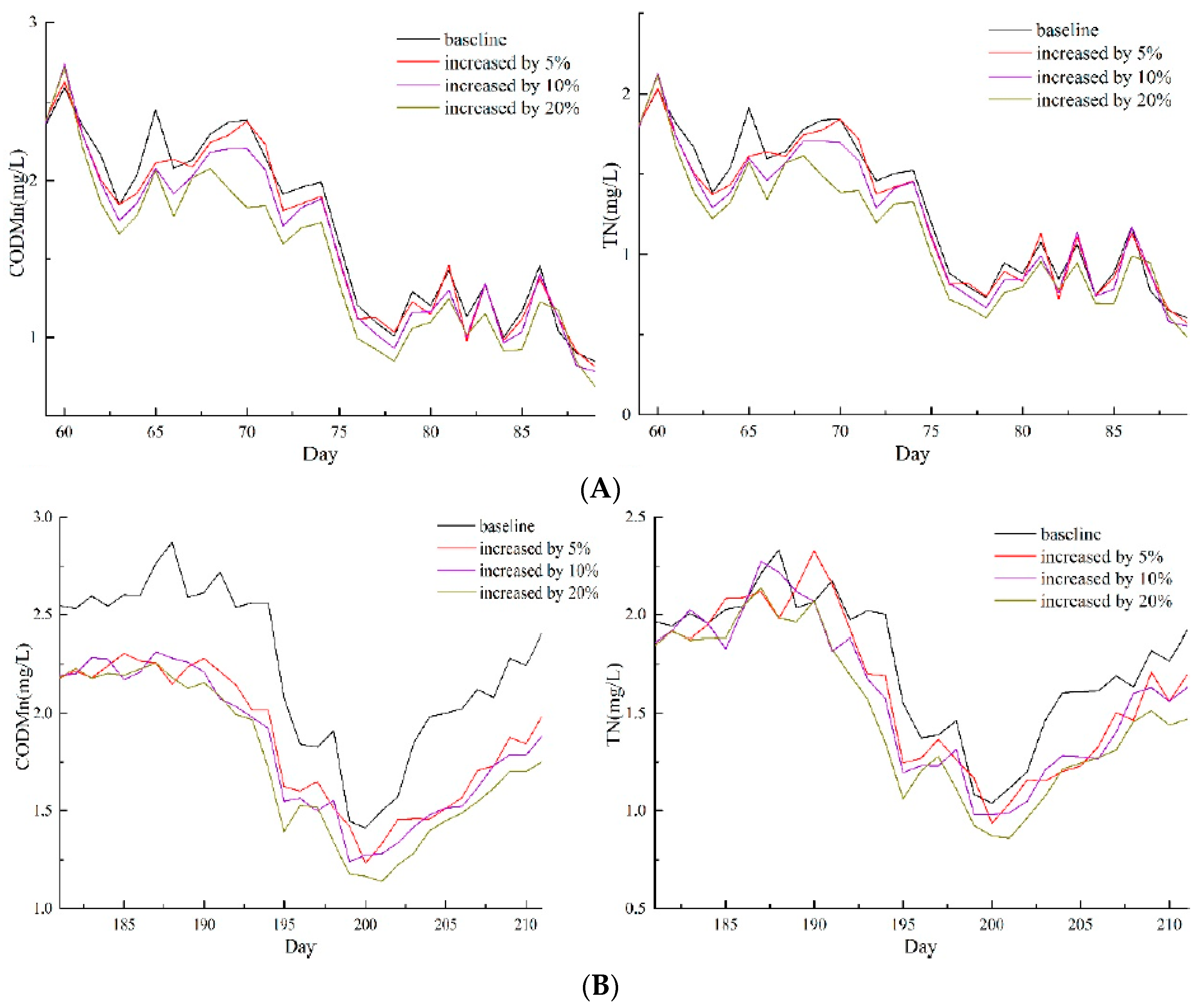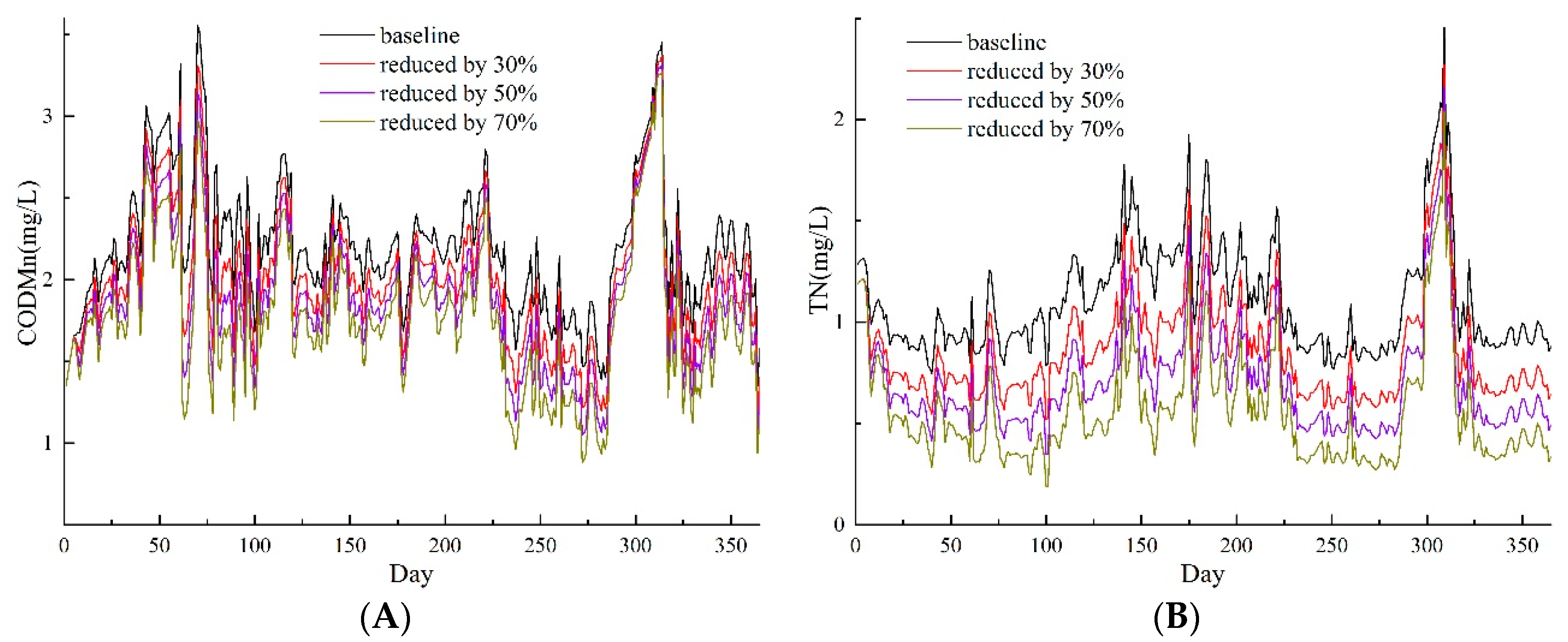1. Introduction
Drinking water safety is a global issue. In China, over 400 cities have been experiencing serious water shortages, and for 110 cities these shortages have been extremely serious [
1]. The total water shortage was estimated to represent nearly 30~40 billion m
3 per year [
2]. Moreover, water pollution threatens the drinking water source regions of cities [
3]. In 2014, nearly 1.3 billion tons of drinking water from 329 investigated cities were polluted, and tens of millions of residents were affected [
4]. The water resource shortages and pollution seriously restricted the sustainable development of social economy, and affected the human health and safety [
5,
6,
7,
8]. Water resource saving and exploration, as well as environment protection, are critical and imminent tasks for drinking water safety in cities.
Numerical models are widely used in water quantity and quality management due to their advantages in comparative efficiency, visualization of spatial information, and applications in data-scarce areas [
9]. The typical model categories are hydrological models (e.g., SWAT, MIKE-SHE), hydrodynamic models (e.g., Delft 3D), and water quality models (e.g., QUAL). For water quality management, over the past few decades, water quality models have been developed and applied to quantify the water quality response of the water body to external or internal pollution loads [
10,
11,
12,
13] and to evaluate the effectiveness of various reduction measures in water environment improvement [
14,
15]. Nevertheless, water quality conditions not only depend on external and internal contaminant loads, but are also related to the complicated processes of transport and transformation overland and in water bodies. The processes are driven by weather conditions (e.g., precipitation, temperature, radiation, and cloud cover), hydrological or hydrodynamic conditions (e.g., runoff volume and velocity), and so on. Thus, hydro-meteorological conditions should be considered when capturing the water quality concentrations with detailed spatial and temporal resolutions according to different types of water bodies (rivers and lakes). Although hydrological models can well simulate flow regime variations and are capable of providing hydrological boundaries for water quality models, the resulting resolutions are limited. Hydrodynamics models have advantages in simulating the flow or mixing processes driving the transport of contaminants in the water quality model [
16]. Thus, the integration of hydrodynamic and water quality models is efficient for water quality management, such as in emission reduction assessments and water quality restoration [
17].
The Environmental Fluid Dynamics Code (EFDC), developed by John M. Hamrick in Virginia Institute of Marine Science, is representative of hydrodynamic and water quality models [
18,
19,
20]. The EFDC is a three-dimensional surface water modeling system for the simulation of flow fields, temperature, sediment, water quality, and other factors at different spatial and temporal scales. It has been successfully applied in various water bodies, including lakes, reservoirs, estuaries, bays, and wetlands [
21,
22,
23,
24,
25]. Due to the advantages of open source codes with respect to re-development, high simulation accuracy, and good stability, EFDC has become one of the most commonly used hydrodynamic and water quality models in both China and abroad. Wu and Xu [
26] applied the EFDC in the Daoxiang Lake for chlorophyll-a simulation and algal bloom prediction. Zhou et al. [
27] investigated the impact of the proposed Severn Barrage on the hydrodynamic and salinity processes in the Bristol Channel and Severn Estuary by using the EFDC model with the Barrage module. Arifin [
28] simulated temperature profiles in Lake Ontario and explored spring thermal bar evolution using EFDC. However, most previous applications have focused on the simulations of hydrodynamics and water quality processes in a single lake or reservoir without severe regulations.
Shenzhen is a mega-city in China with over 10 million residents. A serious shortage of water resources exists due to its specific geographic position, as it has no large rivers. Moreover, excessive development through urban construction and industrialization in the past three decades has led to massive pollution problems (e.g., poor water quality and eutrophication), which has directly threatened the safety of drinking water in the city. In this study, cascade reservoirs in the northwest part of Shenzhen were selected as our study area, i.e., the Shiyan Reservoir, the Tiegang Reservoir, and the Xili Reservoir, which are also closely linked by Water Diversion Projects. The hydrological and water quality processes are highly disturbed by both the operations of cascade reservoirs and the external water diversion projects. Therefore, the integrated simulation of hydrodynamics and water quality variations is still a very complicated task in the study area. In addition, identification of the main pollution-related sources of drinking water contamination, and implementation of stricter water resource management measures are urgently required [
29]. The objectives of this study were (1) to capture the complicated hydrodynamics and water quality with high spatial and temporal resolutions in the regulated cascade reservoirs, (2) to assess the impacts of different pollution sources on water quality concentrations (including transferred water in the flood and non-flood seasons, and the effects of reducing pollution load from runoff and transferred water), and (3) to identify the main pollution source of individual reservoirs. The study was expected to yield results to ensure urban drinking water safety in Shenzhen, and provide a reference for water quality assessment and protection of reservoirs (lakes).
2. Materials and Methods
2.1. Study Area
Shenzhen is a major, fast-developing city in the south of Guangdong Province, China. The total population is over 10 million, the majority of which is concentrated in the metropolitan area. The area has a subtropical oceanic climate, which is hot and rainy in summer. The annual average temperature and precipitation are 22.5 °C and 1967 mm, respectively, and over 80% of precipitation occurs in the summer.
Shenzhen is one of the cities with the greatest severity of water shortage in China, as there are no major rivers in this region and there is a huge water consumption requirement for industry and residents. Although there is a large amount of local precipitation, the available water resources are few due to the limited storage capacity of domestic rivers. The local government attached particular importance to construction of water diversion and storage projects. Large numbers of reservoirs have been constructed since the 1960s, which have provided over 80% of water resources to the whole city.
The Shiyan–Tiegang–Xili cascade reservoirs are critical projects located in the northwest of Shenzhen (113°52′–113°58′ E, 22°35′30″–22°42′30″ N) (
Figure 1). These reservoirs serve as drinking water sources for the Bao’an and Nanshan districts, and as storage for water transfer and collection of urban stormwater. The maximum water storage capacity of the cascade reservoirs is over 163 million m
3, accounting for nearly 40% of the total water consumption in Shenzhen. The Shiyan Reservoir, built in 1960, is located in the northwest of the cascade reservoirs. The control watershed area measures 44 km
2, and the total storage capacity is 32 million m
3. The main tributary flowing into Shiyan Reservoir is the Shiyan River (S1). The Tiegang Reservoir, built in 1957, is located in the southwest of the cascade reservoirs, and is the biggest reservoir in Shenzhen. The control watershed area is 64 km
2, and the total storage capacity is 99.5 million m
3. Three main tributaries flow into the Tiegang Reservoir, the Jiuwei River (T1), the Huangmabu River (T2), and the Tangtou River (T3). The Xili Reservoir, built in 1960, is located in the southeast of the cascade reservoirs. The control watershed area is 29 km
2 and the storage capacity is 32.39 million m
3. Two main tributaries flow into the Xili Reservoir, the Baimang River (X1), and the Makan River (X3).
Flow exchanges are highly frequent among these three reservoirs. Nearly 1.20 million m3 of water is diverted to the Xili Reservoir from the East River per day through the Dongshen Water Supply Project (X2), and an average of 1.00 million m3 of water is transferred to the Tiegang Reservoir from the Xili Reservoir per day through the Connected Project (TX). The Tangtou Pumping House, as a water project (ST) taking water from Tiegang Reservoir to the Shiyan Reservoir, transfers an average of 0.7 million m3 water per day. The flow exchanges could increase water turbulence so as to increase the water self-purification capacity and improve water quality. According to the observed data in 2011, the cascade reservoirs supplied 530 million m3 of fresh drinking water, which represented 31.4% of total water supply in the whole city, and collected 28 million tons of stormwater. Thus, the water quantity and quality processes were obviously altered by a high intensity of human activity. This status directly affects the water safety in the Bao’an and Nanshan districts, and even the entire city of Shenzhen.
2.2. Data Description
Observed meteorological data, flow rate, water level data, and water quality concentrations were available for model calibration. Meteorological observation data of Shenzhen was provided from the China Meteorological Data Sharing Service System (
http://cdc.cma.gov.cn/home.do) including daily atmospheric pressure, temperature, solar radiation, relative humidity, cloud cover, wind speed, wind direction, evaporation and rainfall data at meteorological stations near reservoirs. Water level and exchange flow data were provided by the Shenzhen Municipal Water Affairs Bureau. The water quality variables included the chemical oxygen demand (COD
Mn) and total nitrogen (TN). The measurements of COD
Mn and TN concentrations in the laboratory were all conducted following standard national methods [
30]. Water quality data was monitored at around 10-day intervals in the cascade reservoirs, and the pollution loads of the main rivers were provided by the Shenzhen Water Quality Testing Centre.
2.3. Model Description
The EFDC was developed by John Hamrick in 1988 at the Virginia Institute of Marine Science, and is recommended by the United States Environmental Protection Agency (US EPA). The EFDC is a multifunctional surface water simulation system, which includes hydrodynamics, water quality (eutrophication), and sediment transport modules. The EFDC is one of the most widely used three-dimensional models for the simulation of flow, sediment transport, and biochemical processes in water systems. As public domain software, the model application has been reported in more than 100 water bodies all over the world, including rivers, reservoirs, lakes, estuaries, wetland and coastal seas [
21,
26,
31,
32,
33,
34,
35].
2.3.1. Hydrodynamic Module
A physical description of hydrodynamics in EFDC is based on the Princeton Ocean Model (POM) [
36]. The hydrodynamic module is based on three-dimensional hydrostatic equations formulated in curvilinear orthogonal horizontal coordinates and a sigma vertical coordinate [
37]. It is a foundational module, which can simulate flow field, temperature, and salinity. It provides the hydrodynamic boundary for other modules, and at the same time, biogeochemical processes regarding the relevant water quality variables (e.g., sediment and nutrients) are calculated in the corresponding modules [
38]. The momentum and continuity equations are as follows [
37]:
where
u and
v are the horizontal velocities (m·s
−1) in horizontal coordinates,
x and
y, and are curvilinear and orthogonal, respectively;
w is the vertical velocity (m·s
−1) in the stretched vertical coordinate
z;
mx and
my are the square roots of the diagonal components of the metric tensor,
m =
mxmy is the Jacobian of the metric tensor determinant;
Av is the vertical turbulence viscosity coefficient (m
2·s
−1);
Ab is the vertical turbulent diffusion coefficient (m
2·s
−1);
Qu and
Qv are momentum source-sink terms;
f is the Coriolis parameter;
P is the physical pressure (millibar);
ρ is the density (kg·m
−3);
ρ0 is the reference density (kg·m
−3).
2.3.2. Water Quality Module
The water quality model CE-QUAL-IC [
39] is integrated into the EFDC [
40]. Based on the physical conditions provided by the hydrodynamic module and the sediment–water interface behavior, the water quality module can simulate 21 state variables in water column, including four forms of algae, three forms of carbon, four forms of phosphorus, five forms of nitrogen, two forms of silica, chemical oxygen demand (COD), dissolved oxygen, and total active metal. The general governing equation for the water quality state variables is expressed as follows:
where
C is the concentration of a water quality variable (mg·L
−1);
Ax,
Ay,
Az are turbulent diffusivities in the
x,
y,
z directions (m
2·s
−1), respectively;
Sc is the internal and external sources and sinks per unit volume; and the rest of the variables are the same as in the hydrodynamic module. In order to visualize the spatial output of water quality variables, Tecplot software [
41] was adopted on the basis of source code to output simulations of all grids during the simulation.
In the EFDC model, the kinetic equation of COD is
where
COD is the concentration of chemical oxygen demand (g O
2-equivalents·m
−3);
KHCOD is the half-saturation constant of dissolved oxygen required for oxidation of chemical oxygen demand (g O
2·m
−3);
KCOD refers to the oxidation rate of chemical oxygen demand (day
−1);
BFCOD refers to the sediment flux of chemical oxygen demand (g O
2-equivalents·m
−2·day
−1), applied to bottom layer only;
WCOD refers to the external loads of chemical oxygen demand (g O
2-equivalents·day
−1).
The EFDC model considers five state variables for nitrogen: three organic forms (refractory particulate, labile particulate, and dissolved) and two inorganic forms (ammonium and nitrate).
where
RPON is the concentration of refractory particulate organic nitrogen (g N·m
−3);
LPON is the concentration of labile particulate organic nitrogen (g N·m
−3);
DON is the concentration of dissolved organic nitrogen (g N·m
−3);
NH4 is the concentration of ammonium nitrogen (g N·m
−3);
NO3 is the concentration of nitrate nitrogen (g N·m
−3).
3. Model Configuration and Calibration
3.1. Computational Domain and Grid Generation
The topological and bathymetric data provided by the administration office of the reservoirs were used to generate the grid. In this study, the computational grids are at a 50 m × 50 m spatial resolution to represent the complex geometry of the cascade reservoirs. Horizontally, the final grid measures 1096 square cells in the Shiyan Reservoir, 2783 square cells in the Tiegang Reservoir, and 1344 square cells in the Xili Reservoir (
Figure 2). In the vertical direction, the sigma coordinate was adopted and divided into five layers. The depth ratio of each layer was 0.2 from top to bottom.
3.2. Initial Conditions
The simulation period was from 1 January to 31 December, 2011, in which the first month was the spinning-up period. The initial conditions were set according to the observations, including water level, water temperature, flow velocity, and water quality of the cascade reservoirs (
Table 1).
3.3. Boundary Conditions
The horizontal and surface boundary conditions in the model represented external driving forces to the reservoir dynamics. The lateral boundary conditions consisted of tributary inflow rates, associated water temperature, and water quality concentrations. In the Shiyan Reservoir, the Shiyan River (S1), Ejing Reservoir transfer water, and Tiegang Reservoir transfer water (ST) were its inflows. The outflows were water supply to the water plant, transfer to other reservoirs (S2), and a spillway. In the Tiegang Reservoir, inflows included the Jiuwei River (T1), the Tangtou River (T2), the Huangmabu River (T3), and Xili Reservoir transfer water (TX). Outflows consisted of transfer water to Shiyan Reservoir (ST), water supply to the water plant, and a spillway (T4). In the Xili Reservoir, the Baimang River (X1), the Makan River (X3) and transfer water from Xijiang River (X2) were its inflows, while water supply to the water plant (X4), transfer water to Tiegang Reservoir, and a spillway were its outflows.
The surface boundary conditions were described as daily meteorological conditions, including atmospheric pressure, air temperature, relative humidity, rainfall and evaporation rate, solar short-wave radiation, cloud cover rate, wind speed, and its direction. In the modeling process, daily data were organized into a special format of EFDC to represent the meteorological boundary conditions.
3.4. Model Calibration
Hydrodynamic and water quality parameters were adjusted by a trial-and-error approach to obtain good simulation performance. The hydrodynamic parameters were calibrated first, and water quality parameters were then calibrated based on the hydrodynamic boundary provided by the hydrodynamic module. The sensitive parameters were selected according to previous studies [
42] and are presented in
Table 2. Correlation coefficient (
R) and root-mean-squared-error (
RMSE) were used to evaluate different parts of discrepancies between simulations and observations of water levels, concentrations of COD
Mn and TN.
R was used to evaluate temporal variations between the simulations and observations, while
RMSE was to evaluate the average differences between the simulation and observations. Equations (8) and (9) present the formulas for
R and
RMSE, respectively.
where
O and
S are the observed and simulated values, respectively;
N is the number of the time series; and
i is the
ith of the time series. A value of 0.0 for
RMSE indicates a perfect model. Moreover, in our study, if the
R value is no less than 0.50 and 0.80, the simulation performances are satisfactory and good, respectively [
43].
3.5. Simulation Scenarios
In this study, several scenarios were designed to explore the quantitative relationships between water quality improvement in the cascade reservoirs and the pollution load reduction or reservoir operation by the calibrated model. Reservoir operation scenarios were set to assess the impact of reservoir operation on water quantity and quality by increasing transferred water volume during flood and non-flood seasons by 5%, 10%, and 20%. In our study, March (58–89 days) and July (181–211 days) were chosen as typical months of non-flood and flood seasons, respectively. As the main pollution sources of cascade reservoirs, rainfall-runoff and transferred water had different characteristics with respect to water quantity and quality. The amount of rainfall-runoff was quite little (i.e., only 20% of inflow water), but it had very high pollutant concentrations because of industrial pollution and domestic wastewater. In contrast, owing to strict water quality management in the drinking water reservoir, the water quality conditions of transferred water were much better. Since runoff was polluted heavily, the simulated scenarios were designed to reduce CODMn and TN loads by 30%, 50%, and 70%, individually. The reduction ratios of CODMn and TN loads in the transferred water were also 30%, 50%, and 70%.
5. Conclusions
As one of the most important water sources of urban water supply in China, the reservoir water quality directly affects urban water supply security. Hydrodynamics and water quality models can be used to describe the spatial and temporal distributions of water quality variables and provide technical support for water environment management. In our study, a three-dimensional surface water modeling system (EFDC) was used to establish hydrodynamic and water quality model for the regulated cascade reservoirs. The relationships between water quality and improvement measures were quantified and the main pollution sources were identified for individual reservoirs. Results showed the following:
- (1)
The hydrodynamic and water quality processes in the regulated cascade reservoirs were well simulated by EFDC. The correlation coefficients of water level simulation in the Shiyan, Tiegang and Xili Reservoirs reached 0.97, 0.997, and 0.98, respectively. The mean absolute errors were only 0.09 m, 0.08 m, and 0.08 m, respectively. Models could well reproduce spatiotemporal heterogeneity of water quality concentrations (CODMn and TN). Due to the dramatic decrease in water level in the last three months, the simulated water quality concentrations of the Xili Reservoir were overestimated, and the performance was not as good as that of the Shiyan and Tiegang Reservoirs.
- (2)
An increase of transferred water volume, or pollution load reductions of local runoff and transferred water, would improve the water quality conditions in the cascade reservoirs. The most effective method for water quality improvement was to reduce local runoff load for TN and transferred water load for CODMn in the Shiyan Reservoir, reduce transferred water load in the Tiegang Reservoir, and increase transferred water volume, especially in the flood season, in the Xili Reservoir.
- (3)
To improve the water quality of cascade reservoirs in Shenzhen, the control of diffuse rainfall-runoff pollution should be a priority and can be achieved by establishing a sewage discharge permission system, constructing ecological river wetlands, and other physical and biological measures. In addition, sedimentation should be cleaned up regularly to reduce internal pollution, particularly for the Shiyan and Xili Reservoirs. For the cost–benefit analysis, the combination of water transfer and local river treatment is a probable economic strategy for water quality improvement.
Due to the severe disturbance of the Water Diversion Project, the water quality simulation was very complicated. Although the TN simulation performance was slightly weak, COD
Mn concentrations were simulated satisfactorily, particular for the water level. All the simulation performances were superior to those performed in the Shanmei Reservoir and Danjiangkou Reservoir of China [
51,
52]. The simulation performance will be further improved and validated if more observations from different years are collected. Other water quality variables, such as total phosphorus, dissolved oxygen, water temperature, and chlorophyll, should be also simulated with consideration of interaction mechanisms among different variables. Moreover, the ensemble Kalman filter may be a good way to assimilate water quality variables and make significant simulation improvements [
35].
